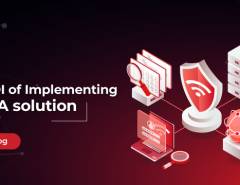With the cybersecurity threat-landscape evolving with each passing day, it becomes important that organizations opt for newer and safer strategies for staying functional without worrying about cyber-threats. Moreover, organizations must readily focus on cybersecurity while keeping a track of available insights, lingering challenges, and even the existing issues. Not just that, enterprises must also abide by the compliance issues associated with cybersecurity as any act of data theft or breach can have catastrophic consequences— both for the consumers and businesses. As companies have so much to worry about, standalone security strategies are often insufficient in the long run. This is where a multi-layered approach works perfectly for enterprises.
Why do we need a Multi-Layered Security Module?
With Internet opening the floodgates for hackers, it is important to analyze every aspect of the online domain to keep threats at bay. Social engineering threats aren’t restricted to a single organizational layer and it’s only appropriate that we consider multiple-layers of security before drafting a cohesive strategy. With criminals targeting end-users, entry points and even databases, the best security approach would be to cover each layer without letting out confidential or proprietary information. With a multi-layered security strategy on-board, there is always a contingency plan in place in case a system breaks down, without prior intimation.
Read More: 5 Essential elements of a cybersecure network
Physical Security: Demystifying the First Layer
Before starting off with any discussion related to cybersecurity and the associated layers of safety, it is important to consider the physical aspects of the same. Be it a simple smartphone or a more convoluted gadget, physical security comes across an integral part of the in-depth defense strategy. The basic ingredients of a physical security layer include antivirus, device control features, asset management to monitor the software/hardware changes, password protection and other strategies that can help safeguard the information access.
Network Security: Securing the Data Channels
With physical security requirements addressed, it is time that organizations secure the data transmission channels by creating selective VPNs. With network security being an integral organizational component, companies must look to address the same with urgency. The basic determinants associated with network security include intrusion prevention systems, intrusion detection systems, and firewalls. Basically, it all comes down to the secured sharing of services and data across the physical network and online domains.
Application Security: Safeguarding Additional Information
There have been certain standards set for securing individual applications associated with an organization. This approach involves deploying additional login details, security defenses for standalone applications, passcode protection and restriction of unauthorized applications within the network. Having this layer of security in place allows individuals and companies to utilize device functionality without compromising on confidential information.
Analytical Security: Securing Network Activities
The last cybersecurity layer aims at safeguarding the concerned analytics for monitoring the network traffic in a more cohesive manner. This security layer analyzes the entire threat landscape and fine tunes the advanced analytics involved with network activities.
How Seqrite’s UTM and EPS can Assist Organizations?
Seqrite’s Unified Threat Management solution comes across as a multi-layered network security strategy for the concerned enterprises. This one-stop solution covers every possible gateway security requirement, allowing businesses to focus solely on the business impact. Seqrite UTM ascertains the mentioned security layers and comes forth with a unified strategy for dealing with the threats. Be it offering gateway antivirus for rendering network security to enterprises or working alongside functional IPS and IDS services, UTM covers the most important aspects of a multi-layered network security approach.
Apart from that, Endpoint Security solution from Seqrite can also address certain security layers via Advanced Device Control, Application Control, Web Filtering, Anti-Ransomware and other features.
Efficient EPS and UTM solutions also assist organizations with computer hardening and device hardening— two of the critical components of a multi-layered cybersecurity plan.
In a nutshell, a multi-layered security approach requires an organization to deploy UTM and EPS solutions and Seqrite is one reliable security solution provider that can effectively handle these requirements for enterprises of varied scales.
As an IT security partner for your business, Seqrite provides comprehensive endpoint security from advanced cyber threats. To know more, visit our website or




